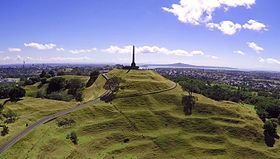One Tree Hill, New Zealand
| Maungakiekie | |
|---|---|
| One Tree Hill | |

Maungakiekie / One Tree Hill after the removal of the "one tree".
|
|
| Highest point | |
| Elevation | 182 m (597 ft) |
| Coordinates | 36°54′0″S 174°46′59″E / 36.90000°S 174.78306°ECoordinates: 36°54′0″S 174°46′59″E / 36.90000°S 174.78306°E |
| Geography | |
| Location | North Island, New Zealand |
| Geology | |
| Volcanic arc/belt | Auckland volcanic field |
Maungakiekie / One Tree Hill is a 182-metre (597 ft) volcanic peak in Auckland, New Zealand. It is an important memorial place for both Māori and other New Zealanders. The suburb around the base of the hill is also called One Tree Hill. It is surrounded by the suburbs of Royal Oak to the west, and clockwise, Epsom, Greenlane, Oranga, and Onehunga. The summit provides views across the Auckland area, and allows visitors to see both of Auckland's harbours.
The hill's scoria cones were erupted from three craters – one is intact and two have been breached by lava flows that rafted away part of the side of the scoria cone. Lava flows went in all directions, many towards Onehunga, covering an area of 20 square kilometres (7.7 sq mi), making it the second largest (in area covered) of the Auckland volcanic field, behind Rangitoto Island. The age of eruption is currently unknown, but it is older than 28,500 years as it has a mantling of volcanic ash erupted at that time from Te Tātua-a-Riukiuta volcano.
The Māori name Maungakiekie means "mountain of the kiekie vine".Māori also knew it as "tōtara that stands alone". The mountain and its surrounds were home to the Te Wai ō Hua tribe from the early 1700s and probably before that time. Other Māori tribes in the Auckland area can also trace their ancestry to the mountain.
Maungakiekie was the largest and most important Māori pā in pre-European times. The cone and its surroundings are estimated to have been home to a population of up to 5,000. At this time, the Nga Marama chief Kiwi Tamaki held the pa and used its strategic placement to exact tribute from travellers passing from Northland to the rest of the North Island through the rich isthmus. Its position between the Waitemata Harbour to the east (opening upon the Pacific Ocean) and the Manukau Harbour to the west (opening onto the Tasman Sea) offered a wide variety of seafood from the two harbours. The volcanic soil on the scoria cone was highly fertile, and the inhabitants terraced the slopes extensively. The hill was relatively easy to defend from raiding parties from other tribes due to its steep sides and imposing palisades. Waiohua occupation of the Māori pā ended around 1740-1750 AD when they were defeated in a war against the invading Ngati Whatua-o-Kaipara The pā was abandoned around 1795 AD with the death of Te Taou leader Tuperiri
...
Wikipedia
